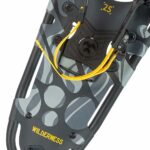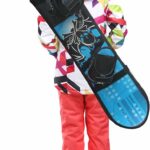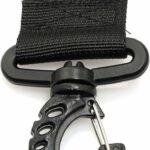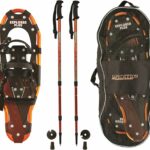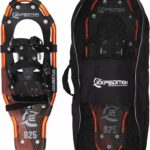Heading out into the snowy wilderness and curious about how to gear up with snowshoes? There’s no need to feel daunted. This article will guide you through the process, from selecting the right pair for your size and gender, to adjusting the bindings, to properly strapping them on, all the way to mastering the distinct snowshoeing gait. With the know-how contained in this guide, you’ll be traipsing through snowy landscapes with assurance and ease in no time. Now, let’s strap in and get you on your way to a thrilling snowshoeing adventure!
Understanding What Snowshoes Are
You might have seen them and wondered what’s with those tennis racket-looking gear strapped onto people’s feet during snowy weather. Well, those are snowshoes. Snowshoes distribute a person’s weight over a large area so that they won’t sink into the snow, a feature known as flotation. You get to float on snow as you walk or hike!
History of Snowshoes
Snowshoeing wasn’t always the recreational activity that it’s known for these days. Its roots can be traced back as far as 4,000 to 6,000 years ago in Central Asia. Snowshoes were first invented for practical purposes such as hunting and moving across snow-filled landscapes where regular shoes would fail. Their use gradually spread to North America where snowshoe designs evolved based on the specific needs of various tribes.
Different Types of Snowshoes
Snowshoes come in different types and sizes for various activities and snow conditions. We have recreational snowshoes, perfect for beginners, for light hiking and walking on trails. Backcountry snowshoes are designed for icy, steep terrains and deep snow, ideal for advanced or experienced snowshoers. Lastly, there are running snowshoes, lightweight, and designed for speed and agility.
Why Use Snowshoes
Snowshoes are not just about historical novelty. They provide considerable benefits. If you’re into outdoor activities, snowshoes allow access to places that would have been difficult to reach due to snow. By distributing your weight, snowshoes help you to float and walk on top of the snow, making hiking less strenuous.
The Right Snowshoes For You
Just like choosing the right pair of shoes, there’s no one-size-fits-all when it comes to snowshoes. Consideration should be taken based on weight, size, activity and materials.
Choosing your Snowshoes Based on Weight
One of the main factors for choosing snowshoes is your weight, including the gear you’ll be carrying. Snowshoes that are too small might not provide enough floatation, causing you to sink into the snow. On the other hand, snowshoes that are too big could be cumbersome.
Recommended Sizes For Different Activities
In addition to weight, the type of activity you’re going to engage in also determines the size of your snowshoes. For trails and packed snow, smaller-sized snowshoes will do the trick. If you’re up for off-trail excursions, throughout deep, fresh snow, go for larger snowshoes for better floatation.
What Material to Look For
As for the materials, modern snowshoes are often made of lightweight metals like aluminum and durable synthetic materials. The traditional wooden type is also an option, which offers a more authentic, vintage feel.
Ascertaining Suitable Clothing
Snowshoeing is a physical activity, as such, dressing appropriately is key to enjoy your snowy adventures.
Best Materials for Cold and Snowy Conditions
Look for clothes made from materials such as merino wool or polyester for base layering. These materials wick moisture away from your body, keeping you dry and warm. Avoid cotton as it absorbs moisture and tends to stay wet.
Layers: How Many and What Kinds
Layering is your best friend when it comes to dressing up for snowshoeing. You’ll need a base layer for moisture control, an insulating middle layer for warmth, and a protective outer layer against wind and precipitation.
Importance of Water-Resistant or Waterproof Gear
Water-resistant or waterproof gear is another essential. They protect you from getting wet and cold. From waterproof pants, jackets, gloves, and boots, owning the right snow gear enhances your snowshoeing experience.
Familiarizing with Snowshoe Parts
Before strapping on your snowshoes, it’s important to understand their different parts.
Understanding the Binding
The binding attaches your boot to the snowshoe. It’s important that your snowshoe binding is compatible with your footwear. Most bindings are fully adjustable for a range of foot sizes and types of footwear.
The Importance of the Crampons
The crampons, or metal teeth located on the bottom of the snowshoes, provide grip and prevent you from slipping on icy or hard-packed snow. The more aggressive the crampons, the better they will handle steeper and icier terrain.
Different Parts of the Deck
The deck is the large, flat part of the snowshoe that provides the flotation. Snowshoes designed for deep snow have larger decks, while those made for trails and packed snow have smaller decks.
The Purpose of the Heel Lift
The heel lift or climbing bar can be flipped up under your heel to reduce calf strain when navigating steep uphill terrain. Many people find this feature highly valuable on longer, steeper hikes or when carrying a backpack.
Fitting Your Snowshoes
Just like any other footwear, fitting your snowshoes properly is crucial for your comfort and safety.
Positioning Your Foot Correctly
Your toes should be near the edge of the shoe, not hanging over. The snowshoe should cradle your foot comfortably but snugly.
Tightening the Binding Securely
To secure your boot, tighten the bindings. Make sure you can wiggle your toes comfortably, but your foot should not slip sideways or move forward with each step.
How Tight Should Snowshoes Be?
Snowshoes should be tight enough to prevent your foot from moving around. However, it should not be too tight that it constricts your foot or limits your circulation.
Practicing First Steps in Snowshoes
Walking in snowshoes can feel awkward at first, but you’ll soon get the hang of it.
Walking Forward
For walking forward, place your feet wider than your hips to avoid stepping on the frames. Lift your foot slightly off the ground and slide it forward in a gliding manner.
Backing Up in Snowshoes
Backing up can be tricky. The tip is to make sure your path is clear before stepping backward.
Turning and Side Stepping
For turning, the easiest method is to swing wide with your outside foot and bring your inside foot to meet it like you’re turning around. As for side stepping, lift your foot high and step to the side, repeating the process until you’ve completed the turn.
Mastering Snowshoe Techniques
It’s time to amp up your snowshoeing skills and conquer lows and highs!
Snowshoeing Up a Slope
For uphill terrain, place your weight on the balls of your feet. This engages all the crampons for maximum traction. Using heel lifts or climbing bars can help reduce calf fatigue on steeper gradients.
Snowshoeing Down a Slope
Descending requires shifting your weight to your heels to keep your balance. Make sure your weight is over your snowshoes and take short, controlled steps.
Traversing a Slope
When moving across a slope, make sure to dig the side of the snowshoes into the snow, creating a stable platform before moving the other foot.
Staying Safe While Snowshoeing
Nothing spoils a fun snowshoeing experience like an unfortunate accident, so it’s vital to take safety precautions.
Importance of Good Footing
Always ensure you have secure footing before taking the next step. Pay attention to your crampon engagement and work with the shape of the terrain.
Being Aware of Weather and Avalanche Conditions
Before heading out, check the weather forecast and avalanche conditions. Being aware of potential risks can prevent unexpected occurrences.
Benefits of Using Poles
Having poles can significantly improve your balance and provide support in uneven terrain, reducing the risk of falls.
Maintaining Your Snowshoes
To ensure long service and optimum performance, proper care of your snowshoes is necessary.
Cleaning After Use
After each use, clean your shoes to remove any dirt or snow. This prevents the parts from rusting and the straps from freezing or becoming brittle.
Storing Properly
When not in use, store them in a cool and dry place. Snowshoes should be hung or stored flat to preserve their shape.
Inspecting Before Each Use
Before wearing, inspect your snowshoes for any wear and tear. Check the frames, decking, bindings, and crampons for any damage.
Respecting Nature and Trail Etiquette
Remember, you’re an invited guest in nature’s backyard, making respect for the environment and fellow trail users important.
Leaving No Trace
Try to follow the “Leave No Trace” principles. Stick to trails and avoid disturbing animals or their habitats.
Respecting Wildlife
Don’t feed or approach any wildlife you may encounter during your excursion. Observe them from a distance.
Sharing the Trail with Others
Be considerate to other trail users. If you’re on a shared trail with skiers or snowmobiles, yield the right of way.
Venturing out in the snow on a pair of snowshoes is a special experience. Gear up, stay safe and enjoy the beauty of the winter landscape around you. Happy snowshoeing!
- What Snowboard Bindings Should I Get? - January 23, 2024
- What Size Screws For Snowboard Bindings? - January 23, 2024
- How To Snowmobile On Water? - January 23, 2024

